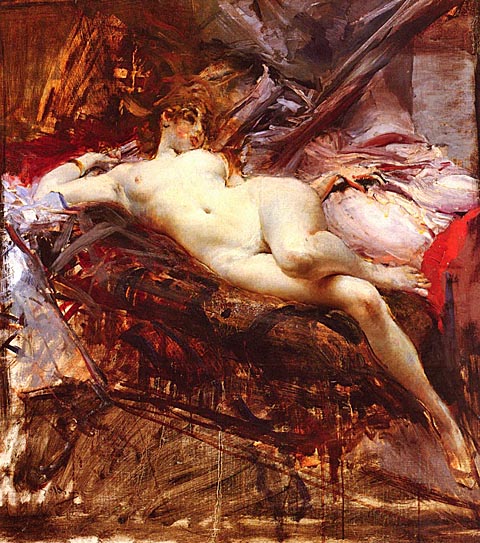 The Maiden by
The Maiden by boldini
See the post before this ,we got mixed up,it should have been after this.
On the occasion of the celebrations for the 150th anniversary of the unification of Italy, the Italian government presents a major exhibition to demonstrate how Italian painting represented the events between 1859 and 1861.
 boldini
boldiniThe exhibition will present the works of the greatest artists of the time (including Francesco Hayez, Giuseppe Molteni, Domenico and Gerolamo Induno, Eleuterio Pagliano, Federico Faruffini, Giovanni Fattori, Silvestro Lega, Odoardo borrani ,Michele Cammarano and Giuseppe Sciuti) and highlight how their reading of the events of those years favoured a heartfelt portrayal of popular accession despite a more obvious and rhetoric celebration.

magenta by induno
There will be compared, for the first time, the monumental paintings by Fattori and Gerolamo Induno, and to highlight how both artists, albeit with different languages, aspired to the same objective: to represent the fundamental battles for the conquest of Italy by moving attention from military aspects to the ideals that were intellectual and those which were popular.

crimea .battle of cernaia by induno.Bersaglieri attack Russians
On display will be possible to admire the celebrated battle of Cernaia by Gerolamo Induno who participated personally in the Crimean War and the famous battle was immortalized on canvas in a work which will serve as a model for the whole period .
 Among the best known artists of the era is Giovanni Fattori, however he did not participate directly in the second war of independence but knew how to make, perhaps more than any other, the feeling of the Risorgimento, realizing epic masterpieces that were artistically comparable to the most beautiful pages of Tolstoy's war and peace.
Among the best known artists of the era is Giovanni Fattori, however he did not participate directly in the second war of independence but knew how to make, perhaps more than any other, the feeling of the Risorgimento, realizing epic masterpieces that were artistically comparable to the most beautiful pages of Tolstoy's war and peace.
In the works of lombards Eleuterio Pagliano (above)and Federico Faruffini as in those of Neapolitan Michele Cammarano(below) you can admire the revolutionary and impressive realism that inspired the imaginary film directors as Blasetti and Visconti who to the tale of the Risorgimento devoted some of their masterpieces.
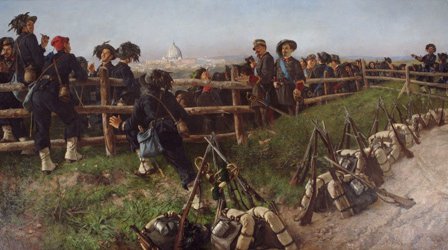
Under show, then, the story of some of the most important vicissitudes of Italian history, facts and revolutionaries of 1848 are prerequisite to understanding the events from 1859 to 1861, the myth of the five days of Milan and the wound to the heart of ' Rome '.the working class or peasant classes participation in the war and the epic of history in the works of Hayez, Molteni, Induno.
And again, the people's spirit of the epic of garibaldi's thousand, the myth of the red shirts and the figure of Garibaldi interpreted by facttori, Gerolamo Induno, Filippo Liardo and Umberto Coromaldi.
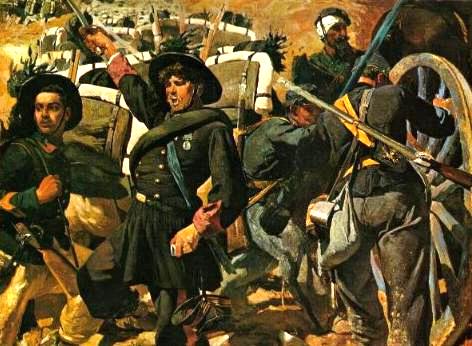
cammarano
With the disappointments of Villafranca and Aspromonte, dramatically recorded with masterpieces by Domenico and Gerolamo Induno, the exhibition starts at the end.
 Cane60mm here in metal
Cane60mm here in metalThe tragic painting of Fattori, It is the emblematic work of this period, the symbol of the thoughts and worries that characterize those years, perhaps, as has been widely defined, the truer and antiretorico monument to the fallen of the wars of the Risorgimento.

volunteer leaving for the war
War creates friction and anguish but also creates feeling and maybe the greatest art that ever came out of Italy was during the wars with Austria : as we have seen ,the great masters such as Fattori were the real eyes of the war and also fought in them. The artists in a land where photography was only in its infancy recorded events sometimes with too much imagination but ones like Fatttori recorded events like a faithful jounalist honest to his craft and to whom newspapers like the Sun would have been anathema, where the writer is merely the tool of the owner and

where with one swipe of his dishonest pen wipes away a reputation. The "Macchiaioli" were a group of painters dedicated to a natural style of art and they were like that faithful journalist who never recorded anything unless they actually saw it.When Wilde said that A;rt is there for its own sake he could also have said "But it records our sentiments too".

cavalry on the road by fattori
Much more than photography pictorial representitive art has the power to go deeper than a photo and bring out the inner idea of a situation or person.We owe much to the artists of the risorgimento (thats if you care about the human rapport)due to their seriousness in expressing feelings that were not always shared by others, more impoortantly they gave us a notion of the atmosphere of the times albeit hidden.
The invasion of Trentino of 1866 was an episode of the third Italian war of independence, which consisted in successful attempt by General Giacomo Medici and his regulars, trying to force the Austrian defences through the Valsugana Trentino and open the way towards Trento.

All small scale Bersaglieri are done by the fantastically talented Roberto Casti .Look at the photography too.guys a genius
the outbreak of the third war of independence, on 23 June 1866, the Italian army was divided into two armies: the first, in command of La Marmora, was allocated in Lombardy to the West of the Mincio towards the strongholds of Quadrilateral; the second, in Romagna, South of the Po, we4nt towards Mantova and Rovigo.

At the outbreak of the third Italian war of Independence (June 23, 1866), Giuseppe Garibaldi received the order to take up positions with his volunteer force the Hunters of the Alps (Italian: Cacciatori delle Alpi) along the frontline between Lombardy and Trentino.

Already on the 21 June, two days after the Declaration of war, Garibaldi commanded the 2nd Regiment Volunteers Italians and the 2nd Battalion bersaglieri and her had to reach the border positions, especially mount Suello, a place that dominated the plain of Oneda and the strategic border crossing the bridge over the Caffaro. The move seemed obligated because, between the two lakes, there was no other way forward with artillery. The eastern shore of Lake Garda, on the other hand, was guarded by the fortresses of Verona and by Austrian naval superiority.
Initially Garibaldi could only muster 4 battalions, but in the end managed to obtain some 38,000 men, which were to face the roughly 15,000 Austrian regulars under general baron Franz von Kuhn(above). The Austrians were supported by their fleet on Lake Garda.
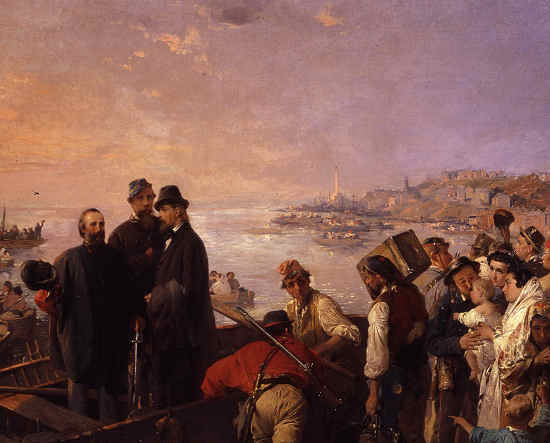 Induno.The 1,000 leave for Sicily
Induno.The 1,000 leave for Sicily First actions.The long Alpine front, was therefore entrusted to the volunteers of Giuseppe Garibaldi, the Italian Volunteer corps, which had to check the front which divided Lombardy from South Tyrol and Trentino.

bersaglieri captain
Garibaldi's men started the fights on June 21, 1866. After some initial minor clashes, they were, due to the Italian defeat at the Battle of Custoza ordered to retreat to the south-western tip of Lake Garda on June 25. As the Austrians choose not pursue, Garibaldi renewed his advance on July 3, but was wounded during an attack on an enemy mountain position. Nonetheless the advance of the Cacciatori was successful and on July 12th Storo and Condino were occupied.

bersaglieri a primolano(induno)
Contemporarily, actions took place near the Tonale Pass, where 3,000 Austrians had established a defensive line between Vezza d'Oglio and Temù. During the battle of Vezza d'Oglio, July 4 the Austrians were dislodged from their positions by an attack of the Italian regular Bersaglieri infantry, which suffered heavy losses. On July 2 an Austrian column crossed the Stelvio Pass and captured Bormio and the Mortirolo Pass, but was later defeated by a force from the Italian National Guard (see Operations in Valtellina).
Condino

Although apparently feeble, the Austrian moves were part of a larger offensive planned by Kuhn which aimed to outflank Garibaldis positions from Lardaro and Bezzecca. On July 16th an Austrian column ousted the Italians from Cimego. Three columns were now encircling the Italians at Condino, but Garibaldi took advantage of his numerical superiority and of the strength of his defensive position and was able to defeat the attack on (July 16th), which forced the Austrians to retreat to their starting positions.
 In The battle as depicted in The Illustrated London News from August 11, 1866On July 21 two Austrian columns clashed with the Hunters of the Alps at the Battle of Bezzecca. After some initial Austrian successes, Garibaldi's counterattacks finally forced them to retreat from Bezzecca as well as from Cimego and Condino.
In The battle as depicted in The Illustrated London News from August 11, 1866On July 21 two Austrian columns clashed with the Hunters of the Alps at the Battle of Bezzecca. After some initial Austrian successes, Garibaldi's counterattacks finally forced them to retreat from Bezzecca as well as from Cimego and Condino. canè
canèthe following days the Italians marched northwards until, on July 20th, they occupied Bezzecca. As the Austrians had suffered a decisive defeat at the Battle of Sadowa, Kuhn had only a few days left before part of his troops would be sent to augment the defense of Vienna. Profiting from the situation, the Italians began to advance on the southern front too, when a division under Giacomo Medici was sent from Padua to fight its way to the city of Trento.
 fixed bayonet besaglieri 1860's .These are the best on the market.Only £5 painted. Order five and get a free box in wood worth 30 pounds.contact me
fixed bayonet besaglieri 1860's .These are the best on the market.Only £5 painted. Order five and get a free box in wood worth 30 pounds.contact me 
The Italian commander had now opened the road to Trento, while Medici had successfully swept the Austrian troops from the Valsugana, reaching Civezzano, not far from Trento, on July 25th. Kuhn was preparing to be besieged in Trento, and had received orders to concentrate on the defense of South Tyrol in the case further defeats.

On July 25th and 26th the Italians attacked near Riva del Garda, but were defeated. However, a truce signed on July 24th, ended all operations. On August 9th the Italian troops received the order to leave Trentino, as a treaty of peace between Italy and Austria was forthcoming. Garibaldi, from the square of Bezzecca, replied with his famous: "Obbedisco!" ("I obey!"). Hostilities finally ceased with the Armistice of Cormons (August 12, 1866).

volunteers in valsugana from fixed bayonet . we sell these in special wooden boxes at very good prices. just a few left.Remember we also have the very best risorgimento pieces on the market at a fraction of any other price.
The game of war with little soldiers can be seen in a museum near Turin,maybe the best soldier museum of all. Museum of Pinerollo
Museum of PinerolloGaribaldini, alpini e bersaglieri , lancers, hussars, knights romans and any soldier in 54mm you can think of. This is what awaits you at this museum near Turin. 72,000 soldiers plus uniforms in the cavalry museum of Pinerolo.Below something of what you can see
 Young Italy is represented here, the face is innocent and beuatiful but with the full breasts of a Mother nurtutring the nation.Below is another image of this female that dominated the thoughts of the Italian and was also transformed into the idea that Italy was a woman and was being put into domestic slavery by the austrians.This was once the language of a country where the poet was king now sadly declined into Berlusconi's media circus.
Young Italy is represented here, the face is innocent and beuatiful but with the full breasts of a Mother nurtutring the nation.Below is another image of this female that dominated the thoughts of the Italian and was also transformed into the idea that Italy was a woman and was being put into domestic slavery by the austrians.This was once the language of a country where the poet was king now sadly declined into Berlusconi's media circus.
The Chief of staff General La Marmora ,between Mantua and Peschiera, , was beaten on the 24 June, in a confused clash at the 2nd battle of battle of Custozza.

Cialdini drove through the Veneto. Past the Po, occupied Rovigo on 11 July, Padua on July 12, July 14, Treviso; San Donà di Piave on 18 July, Valdobbiadene and Oderzo on July 20, Vicenza on 21 July, Udine on 22 July.Meanwhile the volunteers of Garibaldi had gone from the Bresciano in the direction of the city of Trent and had occupied Storo and were preparing the siege of Fort D'ampola and fort Lardaro(below).
plastic 54mm by coma
On 19 July, Cialdini had entrusted his Division to old companions of arms of Garibaldi, tasked with advancing from Padua and the Brenta river, along the Valsugana, towards Trento.
 drummer boy of garibaldi's english brigade
drummer boy of garibaldi's english brigadeThe same 14 July, the King Vittorio Emanuele II of Savoy and the military staff, during a Council of war held in Ferrara, settled finally on an aggressive attitude to the continuation of the war. In particular that Cialdini led an army of 150,000 through the Veneto, while Garibaldi was supposed to penetrate thoroughly in Trentino, approaching as far possible to the capital Vienna. In fact, now that the acquisition of Veneto was certain, it appeared especially urgent the capture of Trentino and the cities of Venezia-Giulia, should they not their escape the peace negotiationsAt The defeat marked a general cessation of operations, with the Italians who fearing a counter-offensive from Austria reorganised. The General outcome of the war was, however, determined by important German Prussian victories on another front (in particular the victory at the battle of Königgrätz on July 3, 1866, of General Helmuth von Moltke). As a result of these events the Austrians retreated to the protection of Vienna with one of three armed forces deployed in Italy and gave priority to the defence of Trentino and Isonzo.

The General outcome of the war was, however, determined by important German Prussian victories on another front (in particular the victory at the battle of Königgrätz on July 3, 1866, of General Helmuth von Moltke). As a result of these events the Austrians retreated to the protection of Vienna with one of three armed forces deployed in Italy and gave priority to the defence of Trentino and Isonzo.
 the volunteers of Garibaldi had gone from the Bresciano in the direction of the city of Trent and had occupied Storo and were preparing the siege of Fort D'ampola and fort Lardaro(below).
the volunteers of Garibaldi had gone from the Bresciano in the direction of the city of Trent and had occupied Storo and were preparing the siege of Fort D'ampola and fort Lardaro(below).
 On 19 July, Cialdini had entrusted his Division to old companions of arms of Garibaldi, tasked with advancing from Padua and the Brenta river, along the Valsugana, towards Trento.
On 19 July, Cialdini had entrusted his Division to old companions of arms of Garibaldi, tasked with advancing from Padua and the Brenta river, along the Valsugana, towards Trento.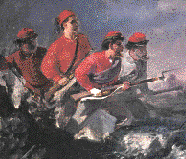
,
CO. BUT. milanese Company . Born as firm molding of plastics, had an Office in via Ettore Ponti. Early 1980s specialized in the production of toys for the beach and after the crisis in the sector, saw an attempt to shift part of the production in China, in 1998 s concluded an agreement and ceded production to Cavallino Toys SpA. The figurines were produced in series of 6 subjects in 6 different poses and were sold in the 1970s, in a transparent plastic bag with cardboard post closing, for the price of 150 lire. A particular feature of the milanese company was producing temporary soldatinii in bakelite, a completely synthetic resin, introduced in 1925, already used by Lineol, which easily broke after a fall or collision. Other articles: Sailors, Bersaglieri, Alpine, Followers, Romans, Gauls, Astronauts etc these soldiers are perrfect for any conversions you have in mind as reghards this period
.

It was considerable forces: it is true that the Austrian commander of Trentino, General Kuhn, had approximately 15,000 men, all good mountain troops with artillery and cavalry, but he was already pressed by Garibaldi in the Southwest. Austrian defensive positions, were all to the border with Lombardy, not towards the Austrian Veneto.
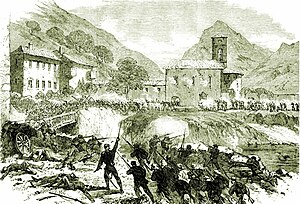
battle of ponte caffaro
On 25 June was the bridge on the Caffaro was taken and occupied: Vanguards assaulted Ponte Caffaro, and went forth through Lodrone until Darzo. Here they were engaged by the Austrians and Chased until the bridge , where he could fight back and put them on the run. until Lodrone.

Meanwhile Garibaldi had stopped an Austrian attack at the battle of Condino (above)and occupied the val di Ledro(below)
.
Already 11 July Franz Kuhn had sent troops to the Valsugana: two infantry companies, one of the Tyrolean Sharpshooters, two of the famous Schützen, a battalion with five companies, and a platoon of engineers. They went to Primolano, at the entrance of the narrow valley. On the evening of 22 July, Kuhn received news of a new initiative and sent three battalions in reinforcement from Verona. On 17 July the Commander of the sector, Carl Pichler von Deeben, commanded a series of pillaging from Primolano to Bassano del Grappa, in Veneto Austria but where the population had already raised the tricolore.

 austrian troops
austrian troopsThe battle of Primolano
The Bersaglieri arrived at PrimolanoIl 22 July but the Austrian avant-garde pressed on to Cismòn and from behind there retired to Primolano. The news, at 7 a.m.was that Carl Pichler von Deeben had concentrated troops (approximately 800 men) on Primolano and went forth to the South towards Cismòn del Grappa.
On the road he received the news that the second Italian column, 3,000 men of Colonel Negri, had come to Enego and threatened his right, he retired and erected barricades at the entrance of the town. A small outpost was left on the heights, in Fastro, with orders to keep as much as possible. The Italians made progress with great caution and arrived only at 2 ' 00 in the afternoon to Primolano, where he was welcomed by the Austrian rifle fire.

3 pm the Austrians, fell back on the trench at Pianello, just north. The Italians there came, but did not attack, pending that the fourth column arrived at Tezze, behind the fortified line.
When Carl Pichler von Deeben realized, he retreated on Tezze.
The volunteers marched to Fastro, which had rejected an attack and the Italian rearguard suffered various losses . At Grigno, the bridge on the torrent omonimo, cutting the road, was partially demolished and towards 10 ' 00 h at night, the troops arrived in Borgo Valsugana.

The Italians repaired the bridge on the torrent and camped before Grigno.

The volunteers, left at 8 a.m., and advanced slowly along the way while some companies of bersaglieri were progressing, covering, along the right and the left slope of the valley up to Castelnuovo...On 25 June was occupied the bridge on Caffaro: Vanguards assaulted Ponte Caffaro, and went forth through Lodrone until Darzo. Here were engaged by the Austrians and Chase intro until ponte, where he could fight back and put on the run the enemy, rejecting until Lodrone.

Battle of Ponte Caffaro

The Headquarters of Garibaldi at Lonato on 27 June 1866 but on the evening of June 25, the day after the battle of custozza Garibaldi received from the Italian Chief of staff, General La Marmora, the order to retreat to the southwestern end of the Lake, the triangle Salò-Desenzano-Brescia with Center in Lonato, in anticipation of a strong enemy beyond the Mincio. Garibaldi moved, then, 15,000 men between Lonato and Desenzano and mise Brescia in a State of defence. Leaving some departments in defence of Rocca of Anfo (the Austrians were called "light of Italy"). The Austrian army not followed, however, the La Marmora in its folding and, already on 1 July, Garibaldi, left three regiments between Salò and Lonato and move more troops in Valcamonica to protect the Passo del Tonale (battle of Vezza d'Oglio), resumed the March towards the Lake IDRO and the border around thirty.
Kuhn was limited to reoccupy positions of border lost, advancing a dozen kilometers up to the Rocca of Anfo(above), except now waive all initiative and immediately dislodge. Meanwhile two small columns were penetrated to the media and the Val Sabbia Valcamonica: you did keep requisendo groceries, explored and they returned to the basis.


The way was now blocked off by two fortified complex in Austria: the so-called strong Lardaro, North along the River Chiese and strong d'ampola, West just above Storo towards Val di Ledro.

the campaian in the Trentino was really decided in the battle against the prussians miles away. And believe it or not they make Moltke t.shirts AND people waer them!!!!! Above a semi-flat Prussian of the war against Austria
The same 14 July, the King Vittorio Emanuele II of Savoy and the military staff, during a Council of war held in Ferrara, settled finally an aggressive attitude to the continuation of the war. In particular the Cialdini main led an army of 150,000 through the Veneto, while Garibaldi was supposed to penetrate thoroughly in Trentino, approaching as possible to the capital. In fact, now that the acquisition of Veneto was certain, appeared especially urgent employment of Trentino and cities of Venezia-Giulia, not their escape the peace negotiations.

Parallel actions on the face and stilfser Joch tonale pass [review]

The municipio di Storo, former House Cortella, was the seat of the headquarters of Garibaldi during the siege to the Fort d'ampola. Parallel took a second small war alpina, further north, there where the Lombardy borders the Trentino on the Passo del Tonale, but this time to flip: one body parts of approximately three thousand Austrians rides the Valley through wooden bridge, until you reach fra Vezza d'Oglio and Temù, near a fortified line held by Royal Army. 4 July rejected a furious assault "at garibaldina", bayonet in cane and almost completely uncovered, launched from the 2nd Battalion of bersaglieri, which they had easily reason. Fell the Commander Colonel Nicostratus Castellini besides 19 other bersaglieri and 60 injured (battle of Vezza d'Oglio).

The Austrian had also advanced to the second major Alpine passes which divide the Lombardy Italian from South Tyrol: the Stelvio pass. On 2 July column had occupied Bormio and the Passo del Mortirolo. The National Guard Mobile attested to shaking Sondalo, knew how to regain lost positions, rioccupandole 11 July (operations in Valtellina (1866))
 volunteer
volunteerThe Austrian offensive, however, it was further fueled by the commands of Trentino and lines footsteps maintained until the end of the war.

The victory of Condino [review]
The plaque on the façade of the Municipio di Storo reminiscent of the headquarters of the Austrian GaribaldiLa reaction appeared sluggish but, in fact, the excellent general Kuhn was preparing a counter-offensive enveloping from North by Lardaro along the Churches, and from the South, on the right flank by Giuseppe Garibaldi, Bezzecca and Val di Ledro, down from the Fort of Ampola. This was preventing Garibaldi to consolidate positions or at least of scompaginarne tiers to delay the advance.

On 16th July the Northern column and the bridge in upon Cimego on Churches, ricacciando volunteers down towards Condino, while the southern column came only to bomb the way towards Storo Condino (battle of Condino).
The action of encirclement was bankrupt and the Austrians did not have sufficient forces to chase the Italians down to the Churches. The road to Trento had too many strong positions and places suitable to struggle because the Austrians care to be an important part of their forces in a single battle.
At Condino and Storo, finally, Garibaldi could always count on a great numerical superiority, forces largely not yet entered into combat. The Kuhn cull the three columns to regain their starting positions.
The advance towards Riva del Garda [review]
 cammarano
cammaranoTHE EYES OF THE WAR
Telemaco Signorini (August 18, 1835 – February 1, 1901) was an Italian artist who belonged to the group known as the Macchiaioli.
He was born in the Santa Croce quarter of Florence, and showed an early inclination toward the study of literature, but with the encouragement of his father, Giovanni Signorini, a court painter for the Grand Duke of Tuscany, he decided instead to study painting In 1852 he enrolled at the Florentine Academy, and by 1854 he was painting landscapes en plein air. The following year he exhibited for the first time, showing paintings inspired by the works of Walter Scott and Machiavelli at the Florentine Promotrice


In 1855, he began frequenting the Caffè Michelangiolo (above)in Florence, where he met Giovanni Fattori, Silvestro Lega, Saverio Altamura
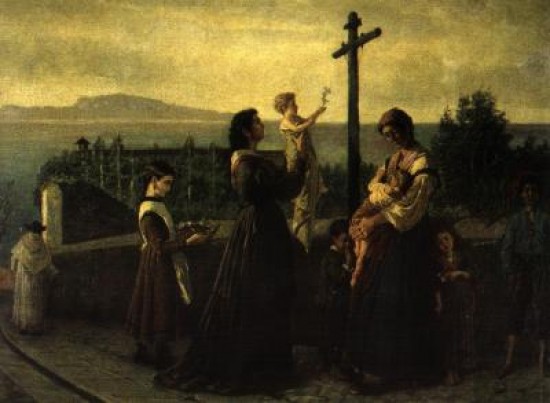 and several other Tuscan artists who would soon be dubbed the Macchiaioli. The Macchiaioli, dissatisfied with the antiquated conventions taught by the Italian academies of art, started painting outdoors in order to capture natural light, shade, and color. They were forerunners of the Impressionists who, beginning in the 1860s, would pursue similar aims in France.
and several other Tuscan artists who would soon be dubbed the Macchiaioli. The Macchiaioli, dissatisfied with the antiquated conventions taught by the Italian academies of art, started painting outdoors in order to capture natural light, shade, and color. They were forerunners of the Impressionists who, beginning in the 1860s, would pursue similar aims in France.
Zandomeneghi
Signorini was a volunteer in the Second Italian War of Independence in 1859, and afterwards painted military scenes which he exhibited in 1860 and 1861. He made his first trip outside Italy in 1861 when he visited Paris, to which he would often return in the decades that followed. There he met Degas and a group of expatriate Italian artists in his orbit, including Giovanni Boldini, Giuseppe De Nittis, and Federico Zandomeneghi; unlike them, however, Signorini remained rooted in Italy.
 boldini
boldiniHe became not only one of the leading painters of the Macchiaioli, but also their leading polemicist. Art historian Giuliano Matteucci has written: "If we acknowledge Fattori
and Lega as the major creative figures of the macchiaioli, then Signorini must surely be recognized as their 'deus ex machina'", describing his role as "that of catalyst and energetic doctrinarian. In transforming attention away from history painting and the academic portrait towards a new poetical interpretation of natural landscape, the part of Signorini was of fundamental consequence to macchiaioli painting."
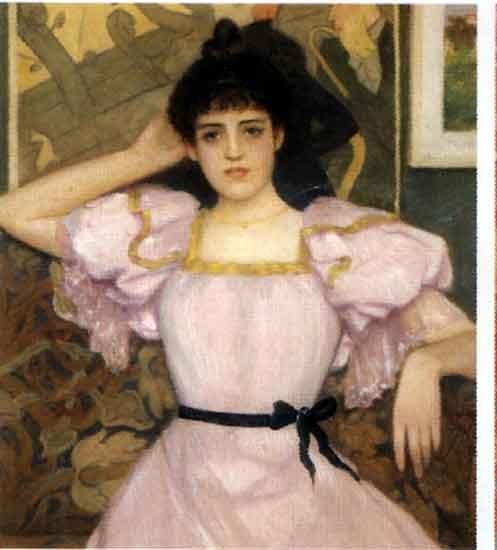 Zandomeneghi
Zandomeneghibelow images of italian cavalry at the time of the wars by fattori
Ward of the Madwomen at S. Bonifazio (1865) below
Among his most notable paintings are The Ward of the Madwomen at S. Bonifazio in Florence (1865, Venice, Gallery of Modern Art in Cà Pesaro) and Leith (1

1881, Florence, Gallery of Modern Art in Palazzo Pitti). The latter, a street scene observed on a trip to Scotland, is predominantly gray in tonality, but dominated by a brightly colored Rob Roy whiskey billboard on the side of a building. Art historian Norma Broude has written of Leith:

On the formal level, certainly, the Rob Roy sign arrests our attention and plays with our expectations here as audaciously as a collage element in an early twentieth-century cubist composition. What permitted and encouraged Signorini's experimentation in this remarkably precocious and unprecedented manner was unquestionably the experience of photography ... For with his vision conditioned by that experience, he could accept—as the eye of the camera accepts— what artists before him would normally have pruned or screened out of their interpretations of such a scene.
 Spartacus done at the start of the wars incorporates the spirit of Italians unwilling to be slaves
Spartacus done at the start of the wars incorporates the spirit of Italians unwilling to be slavesThe influence of photography is often suggested by the asymmetrical compositions of Signorini's works, and his late etchings of street scenes reveal additional influences: those of Japanese art, and Whistler, in their simplifications of shape, atmospheric effects, and flattened treatment of space.
He taught at the Instituto Superiore di Belle Arti in Florence beginning in 1892. Signorini died in Florence on February 1, 1901.

And boldini was just interested in nice looking chicks












No comments:
Post a Comment